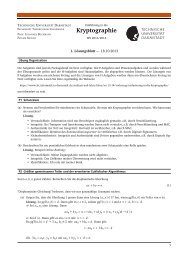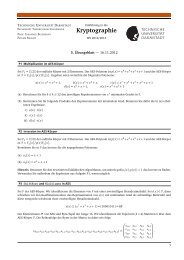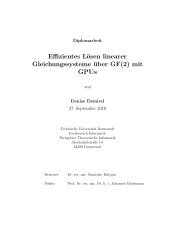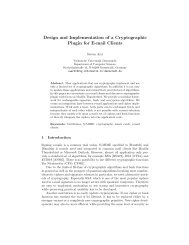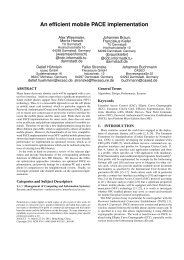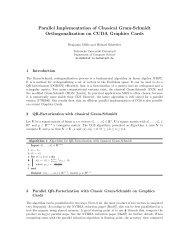Lattice Basis Reduction in Infinity Norm - Technische Universität ...
Lattice Basis Reduction in Infinity Norm - Technische Universität ...
Lattice Basis Reduction in Infinity Norm - Technische Universität ...
Create successful ePaper yourself
Turn your PDF publications into a flip-book with our unique Google optimized e-Paper software.
• Swap a and b.<br />
2. END WHILE<br />
OUTPUT: A reduced basis (a, b) ∈ R n<br />
The exchange <strong>in</strong> Step 3 produces either a well-ordered or a reduced basis.<br />
The algorithm traverses a sequence of well-ordered bases until a reduced one<br />
is found. In order to have a well def<strong>in</strong>ed algorithm <strong>in</strong> Step 1 the smallest<br />
possible µ, that m<strong>in</strong>imizes the norm � b − µa �p for p ∈ [1, ∞], should<br />
be chosen. In general this algorithm term<strong>in</strong>ates after f<strong>in</strong>itely many steps<br />
because the norm of the basis vector decreases with every iteration, except<br />
the last one.<br />
3.4 Inf<strong>in</strong>ity <strong>Norm</strong> Algorithm<br />
As Kaib expla<strong>in</strong>s and proves <strong>in</strong> his dissertation [2] there is a fast way to<br />
calculate the coefficient µ for l∞-norm. This section describes the method<br />
proposed by him.<br />
Let us consider the function f(µ) = � b−µa �∞. It is a piecewise l<strong>in</strong>ear<br />
and convex function with at most n corners. Its m<strong>in</strong>imum, accord<strong>in</strong>g to the<br />
optimization theory, could be found on one of these corners. The reduction<br />
coefficient µ is therefore one of the two neighbor<strong>in</strong>g whole numbers of the<br />
corner that m<strong>in</strong>imizes the function f. In order to f<strong>in</strong>d that m<strong>in</strong>imum, the<br />
elements of the function f(µ) = max fi(µ)|1 ≤ i ≤ n should be taken.<br />
Let us consider the graph of the function f(x) = maxi≤n |bi − xai|, which<br />
is the maximal polygon. The ascend<strong>in</strong>g slope of the function is f + i<br />
|ai| (x − bi<br />
ai ) and the descend<strong>in</strong>g - f − i (x) := |ai| ( bi<br />
ai<br />
(x) :=<br />
− x), where all elements<br />
with ai = 0 are already elim<strong>in</strong>ated. All elements are sorted accord<strong>in</strong>g to<br />
their absolute value, |a1| ≥ |a2| ≥ .... ≥ |an| > 0 without loss of<br />
generality. Let f (k) (x) := maxi≤k |(bi − xai)| be the maximal polygon that<br />
has the k steepest elements. For each k = 1, 2, ...., n we compute the value<br />
of f (k) as an ordered subset of l<strong>in</strong>es, which build the maximal polygon. The<br />
faces of the polygon are determ<strong>in</strong>ed from these l<strong>in</strong>es and from them x (k) ,<br />
which m<strong>in</strong>imizes f (k) , is calculated.<br />
From the elements fk+1 = max (f + −<br />
k+1 , fk+1 ) only the ones with the<br />
biggest f ±<br />
k+1 (x(k) ) values are to be considered. If fk+1(x (k) ) ≤<br />
≤ f (k) (x (k) ), set f (k) = f (k+1) . In case there are more elements with the<br />
same slope, only the ascend<strong>in</strong>g one with the smallest bm<strong>in</strong><br />
am<strong>in</strong><br />
one with the biggest bmax<br />
amax<br />
are considered.<br />
and the descend<strong>in</strong>g<br />
We divide the l<strong>in</strong>e segments of f (k) <strong>in</strong> two groups - R and L, where R<br />
conta<strong>in</strong>s the ascend<strong>in</strong>g and L - the descend<strong>in</strong>g segments. The absolute value<br />
of the slope is m<strong>in</strong>imal for both groups. The value x = x (k) denotes the<br />
m<strong>in</strong>imal po<strong>in</strong>t of f (k) , that is the cross<strong>in</strong>g po<strong>in</strong>t of the topmost l<strong>in</strong>e from<br />
both groups. The biggest element from the groups is denoted by (gL, xL)<br />
10





